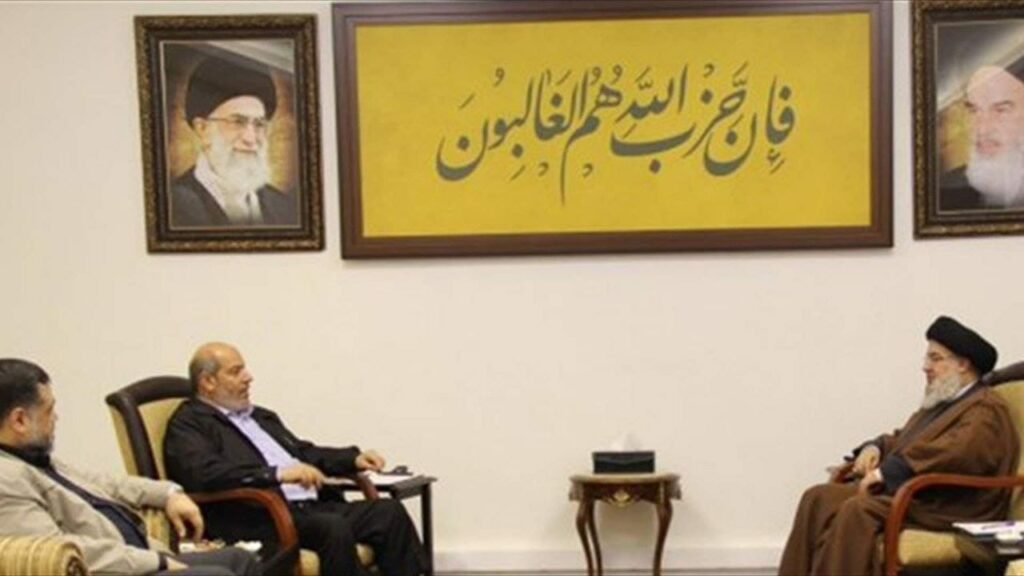Key insights:
In light of the IDF Spokesperson’s publication regarding the level of damage to Radwan Force targets, as well as the IDF’s deployment in the border area, we believe Hezbollah will find it difficult to execute its originally planned “conquest of the Galilee” operation. Nonetheless, according to our assessment from several months ago, Hezbollah retains the potential to carry out targeted offensive and infiltration operations into a specific sector with a limited number of operatives, using the Radwan unit and with the support of its geographical units.
Despite the IDF’s damage to Hezbollah’s infrastructure, we believe that some of them are in the process of being restored and that others will be rehabilitated soon.
Hamas’ “Construction Bureau” is in charge of building the organization’s military-terrorist component as well as directing terrorist assaults on Israeli and Jewish targets. The elimination of prominent Hamas operatives in Lebanon appears to be a targeted action by Israel to undermine Hamas’ ability to direct and incite terrorism from Lebanon. This is especially crucial given the risk of a flare-up during Ramadan.
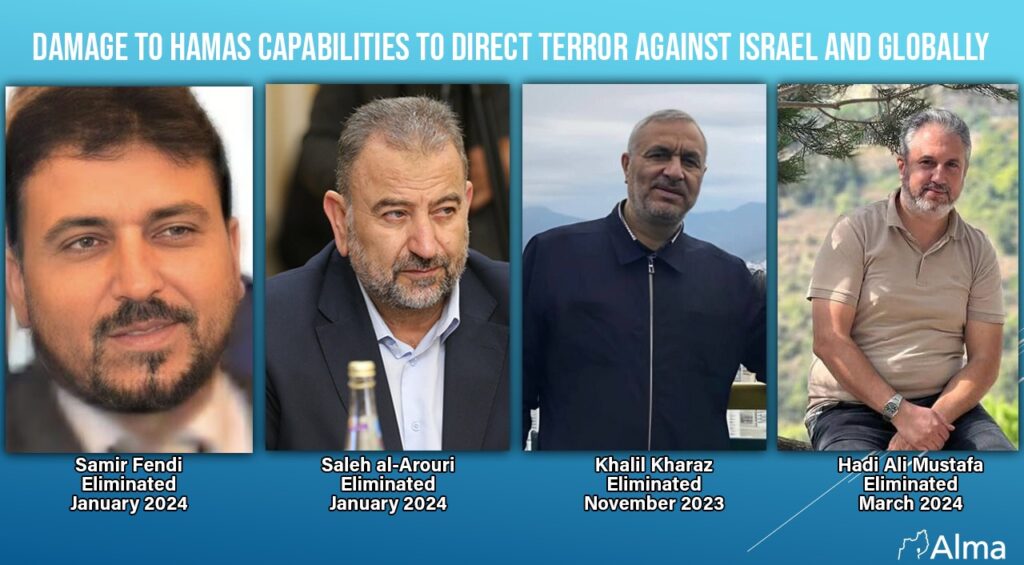
It’s likely that Hezbollah’s willingness to initiate a war with Israel differs from Iran’s. This may enhance our evaluations of Hezbollah’s willingness to take Israel to war in 2023.
Since the beginning of March, there have been 91 ballistic-missile fire incidents, three times more than anti-tank missile attacks (a total of 31). In addition, there has been an increase in UAV launches: since the beginning of March, there have been 17 incidents, compared with 7 incidents in February. Half of the launches were aimed at civilian targets (or with the potential to hit civilian targets).
The Lebanese arena:
War data:
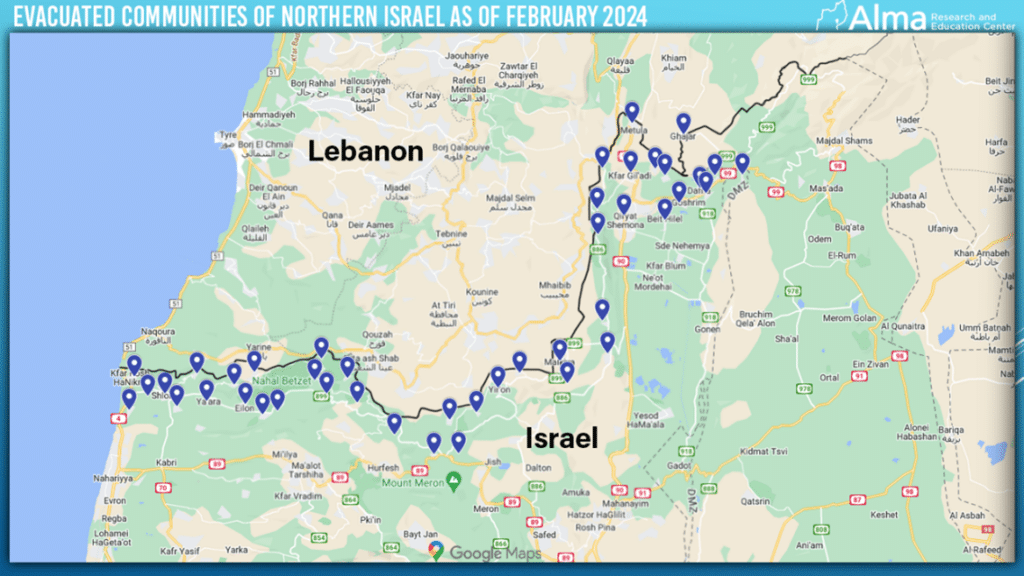
In Israel, the government evacuated 43 communities located up to five kilometers from the Lebanese border. A total of about 61,000 citizens. To them were added several thousand more who decided to evacuate independently.
It should be noted that not all Israeli communities have been totally evacuated, and there is still a civilian presence. This is because these communities rely on tourism and agriculture. Farmers come to work on the land, in the orchards, tending to cow and goat herds. Furthermore, some of the communities’ industrial plants are still operational and employ workers from non-evacuated areas.
The Israeli government has extended the evacuation period until the summer of 2024 (July/August 2024).
Hezbollah has killed 5 Israeli civilians and 1 agricultural worker with foreign citizenship so far. A total of 6 civilians were killed.
Hezbollah claimed responsibility for 56 launching and firing incidents against Israel during the last week, using (Almas) anti-tank missiles, Grads/Falk/Burkan ballistic missiles and UAVs.
This past week there were no direct launches or fire at civilian targets.
12 more times this week ballistic-missile fire was carried out on areas designated by Hezbollah as military targets. In actuality, these targeted locations pose a significant danger of harm to civilian communities.
Prominent launching and shooting incidents against Israel:
(March 16) An explosive UAV was discovered in Israel’s Lower Galilee region near Tiberias. It is unclear when it was launched against Israel, as well as where it came from.
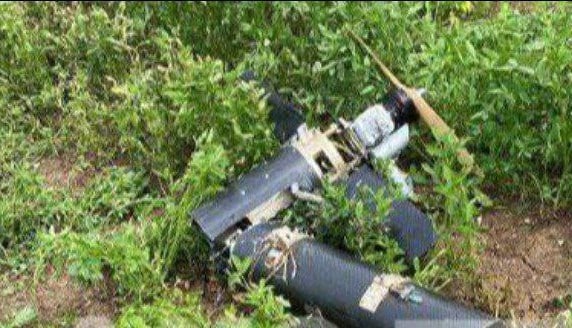
Hezbollah casualties:
During the past week announcements were issued reporting 3 Hezbollah and one Hamas operatives killed.
As of October 8, 2023, a total of 244 Hezbollah operatives have been killed. Most of the operatives killed live south of the Litani River (160 operatives killed, constituting 66% of all the operatives killed). Many Hezbollah operatives and their families live in southern Lebanon near the border with Israel. They operate in southern Lebanon as part of Hezbollah’s geographic units (Nasser/Aziz) and Hezbollah’s designated units (Radwan unit), while assimilating into the civilian population (human shield tactics).
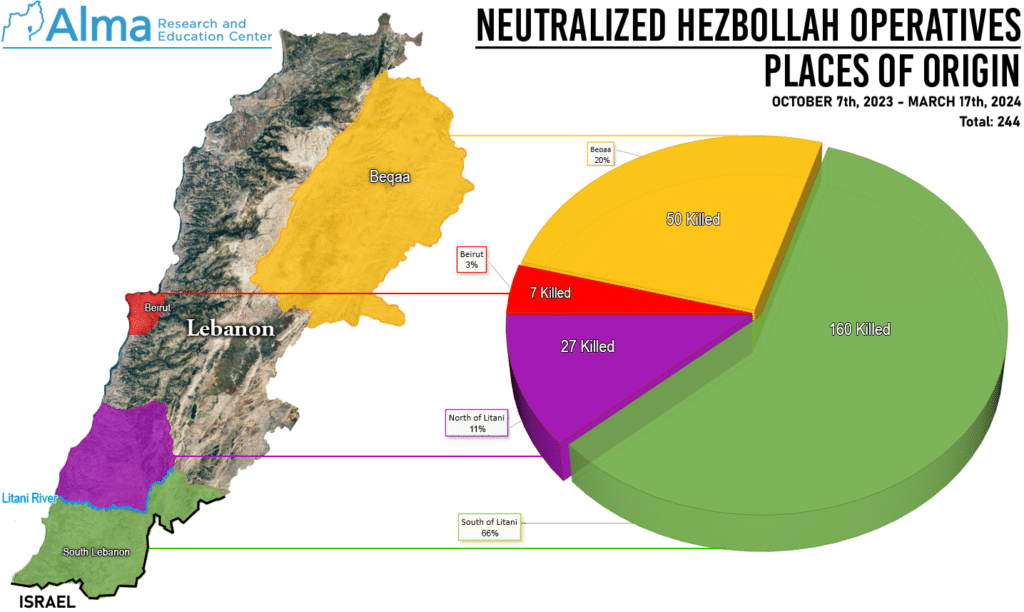
Prominent attacks in Lebanon:
(March 11) At around 10:30 P.M., an Israeli airstrike was carried out against a number of targets in the area of the city of Baalbek in the Bekaa Valley in eastern Lebanon. According to the IDF, the attack was aimed at targets linked to Hezbollah’s air unit. This was in response to a series of UAV launches against Israel in recent days. Please notice the many solar panels on the roof of the building that was attacked. Although a common sight in the Bekaa Valley, it seems that the activity in this structure (storing UAVs and/or their parts) required a distinguishing independent and steady supply of electricity.
This is the second time an attack has been carried out in this area, about 100 kilometers deep in Lebanon, an attack considered relatively unusual. Hezbollah’s strategic assets are deployed in the Bekaa Valley, such as targets belonging to Hezbollah’s aerial unit and long-range missile units. The Bekaa Valley area also serves as Hezbollah’s logistical hinterland. In regards to its aerial unit, we are familiar with three landing pads in the Bekaa Valley that are used to operate UAVs.
Two equations were expressed: the first, established by Israel, states that firing UAVs at Israel will cause harm to Hezbollah’s aerial systems. The second is Hezbollah’s equation, which states that the more pain caused by Israeli attacks, the stronger Hezbollah’s retaliation will be; in our opinion, the heavy barrages fired at the Golan Heights on March 12, demonstrate this.
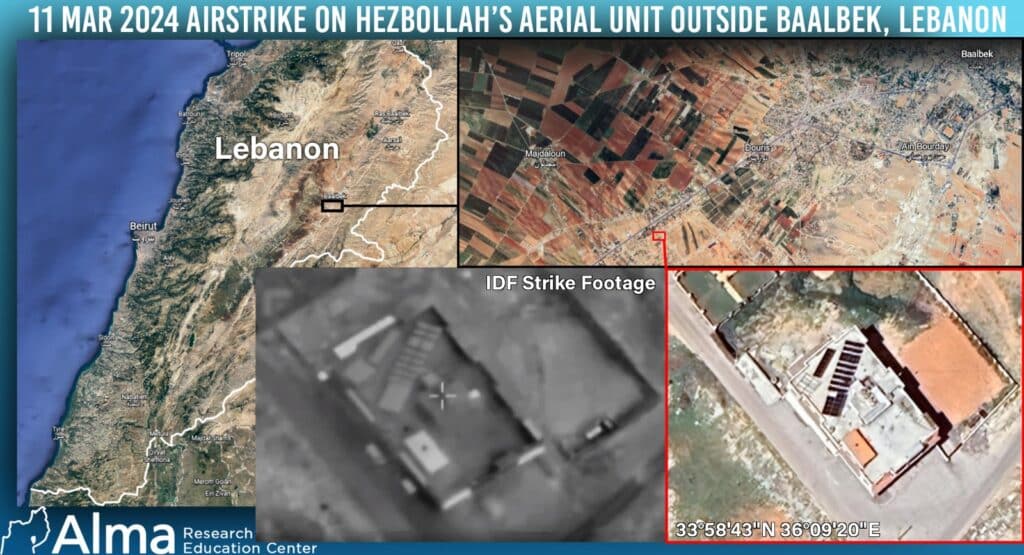
(March 12) Continued airstrikes in the Bekaa Valley: Nabi Chit and Saraain. These are significant assets related to the storage of advanced weapons.
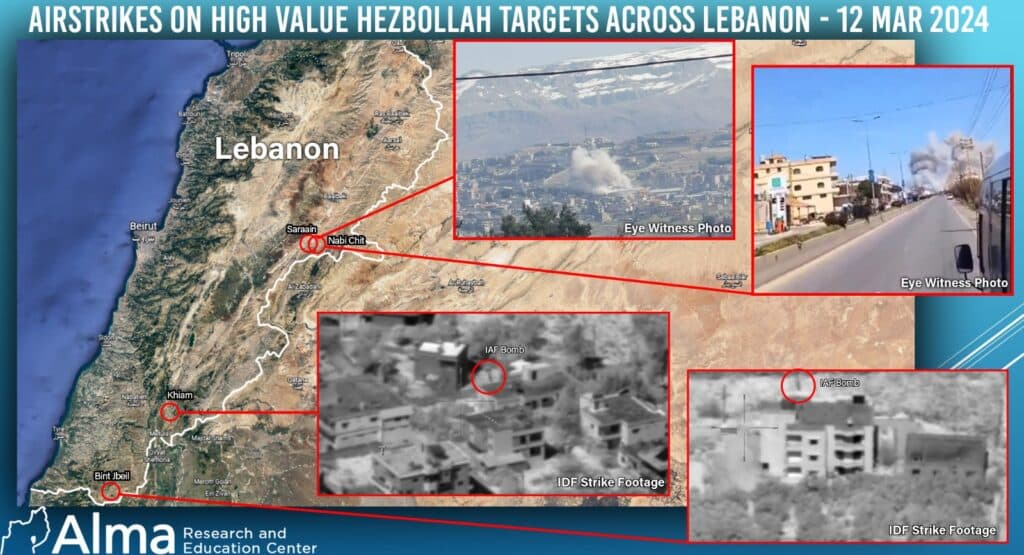
(March 13) Airstrike on a vehicle south of Tyre: According to local reports, Hadi Ali Mustafa, an official in Hamas-Lebanon’s military-terrorist wing, who was involved in activity against Israel, was killed in the attack. In his civilian position, he served as a religion teacher. The location of the attack is near the Rashidieh refugee camp, Mustafa’s place of origin. Israel claimed responsibility for Mustafa’s elimination and confirmed that he belonged to Hamas’ construction bureau and was involved, among other things, in directing terrorist attacks.
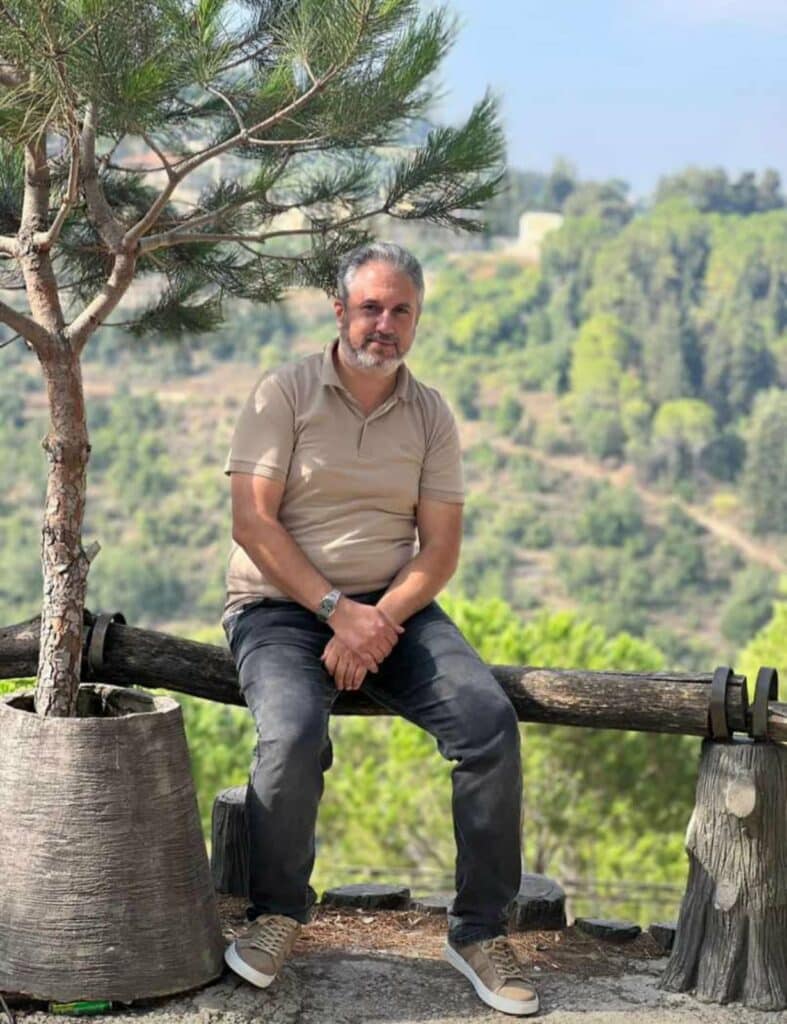
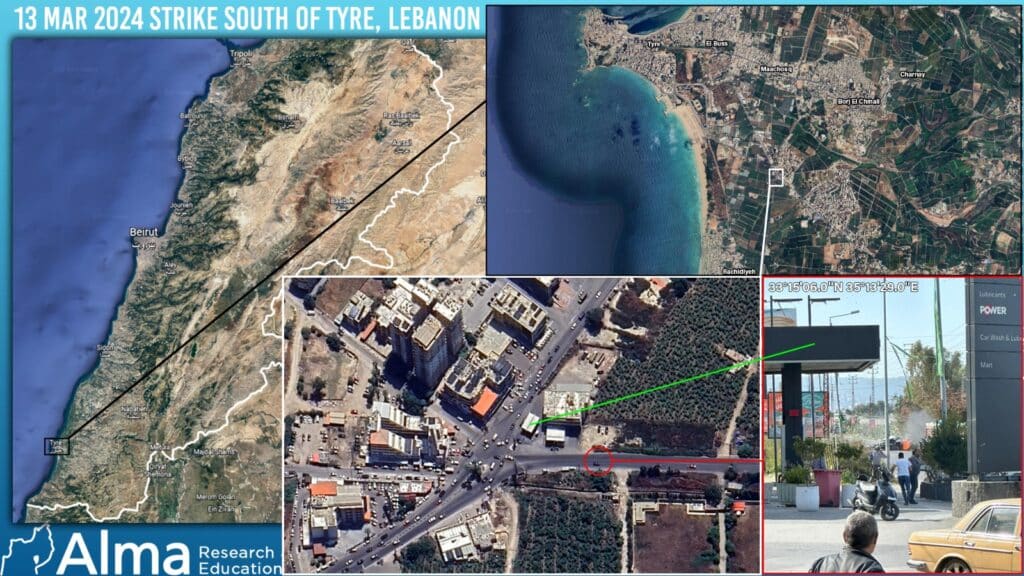
Hezbollah – General:
(March 13) Nasrallah’s speech on the occasion of Ramadan:
Explanation of Ramadan, its holiness and the importance of “martyrdom” expressing deep faith in the Quran (perpetuating and glorifying the culture of death – Hezbollah’s central narrative): “We find acceptance, satisfaction and glory among the families of the shaheeds, and this is what we see every day in Gaza, the West Bank, Lebanon and Iraq.”
As expected, Nasrallah continues to try to maintain the narrative in which Israel is losing and failing in its war goals, despite its strength and US support. In order to try to divert attention from the number of Hezbollah fatalities during the months of fighting, Nasrallah is trying to create an alternative reality in which, according to him, Israel has heavy losses in the northern arena and hides them: “The battle of the Al-Aqsa flood has achieved great and strategic achievements that affect the origin of this entity (Israel) and its future in the region… The number of Zionist fatalities is much higher than what the IDF declares”…
Nasrallah tries to bolster his argument by using examples of the internal political struggle in Israel over the IDF draft law and the reports that the IDF is short of several thousand soldiers and is a weak army: “The enemy that is going to recruit the ultra-Orthodox, who believe that their job is only to learn Torah, is proving that it has a problem with the number of its soldiers and officers.”
Hezbollah’s goal is to deter Israel from starting a war and pledges to continue supporting Hamas in Gaza: “Our role and responsibility are all perseverance and steadfastness; the resistance axis is in a position of strength and the enemy is in a position of weakness.”
(March 12) Nasrallah meets in Beirut with a Hamas delegation headed by Khalil al-Khaiya, deputy Hamas leader in the Gaza Strip. The sides reviewed the latest developments in Gaza, Judea and Samaria and the various arenas. There was also talk of negotiating a complete ceasefire in Gaza and achieving Hamas’ conditions.

(March 13) On the occasion of the month of Ramadan, Hezbollah launched its first campaign to distribute food rations in the Jabal Amal area, especially in the city of Nabatiyeh in southern Lebanon. According to Hezbollah’s announcement, the campaign, called Imam Zine Al-‘Abdin, aims to ensure the basic needs of poor needy families and the destitute.” “The number of families who benefited from the campaign this year reached 1,016 families, excluding the displaced families, which number 625 families.”

(March 16) Reuters reported that Quds Force commander Ismail Qaani visited Beirut last February. He met with Nasrallah for at least the third time since the war began on October 7. According to an “Iranian source involved in the talks,” during the meeting Nasrallah “reassured” Qaani that he did not want Iran to be dragged into a war with Israel or the United States, and that Hezbollah would fight alone. Nasrallah told Qaani: “This is our battle.”
We are unsure how to comment on the report’s credibility. If this claim is genuine, Hezbollah’s willingness to wage war against Israel may differ from Iran’s. This may enhance our evaluations of Hezbollah’s willingness to take Israel to war in 2023.
Lebanon – General:


The Syrian arena:
Prominent airstrikes in Syria:
(March 12) An attack on a Syrian military base on a hill in the Al-Nuria area, north of Khan Arnava in the Syrian Golan Heights. The strike occurred against the backdrop of Hezbollah’s utilization of the Syrian Army’s military infrastructure at the base. According to our assessment, the attack targeted Hezbollah units operating in the Syrian Golan Heights: the Southern Headquarters and the Golan File, which gathered intelligence from this base on Israeli territory through observations and possibly other means to use this information for future activity against Israel. It should be emphasized that in the geographical area adjacent to the Israeli border on the Golan, we are aware of numerous sites where the Golan file and Southern Command operatives are stationed.

According to local reports, on the night between March 16 and 17, an airstrike was carried out in an area Northeast of Damascus. This area, between Nasiriyah military air base and Al-Marah, has several military sites. Videos published on social media accounts show some of the bunkers in the base near Al-Marah exploded and caught fire. Secondary explosions were also visible. The bunker base near Al-Marah is located close to the route of the Iranian land corridor in Syria. It is unclear whether other targets in the region were attacked.
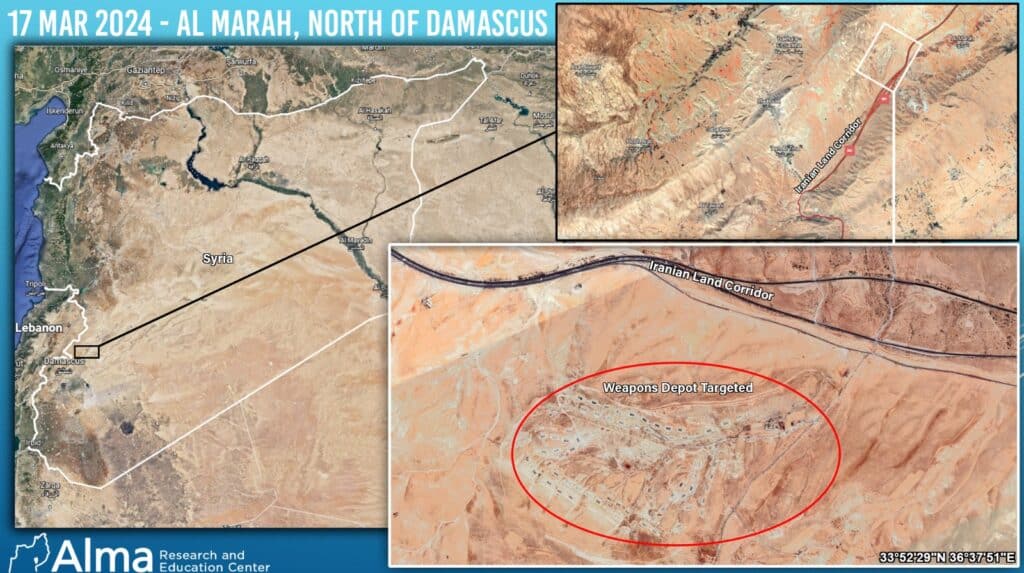
Syria – General:
(March 13) Reports regarding the establishment of another Russian outpost, jointly with the Syrian Army, in southern Syria – the Syrian Golan Heights.
(March 16) A rocket was fired from Syrian territory into Israeli territory. The rocket did not cross into Israeli territory, subsequently landing in Syrian territory. The IDF responded with artillery fire.
(March 16) The Syrian minister of defense met in Tehran with his Iranian counterpart. They discussed ways to deal with the “Israeli attacks.”
The Shiite Axis – General:
The last attack on American bases in Iraq/Syria was carried out on February 20 (it is unclear whether on March 10 the American base in CONOCO (eastern Syria) was attacked by a UAV, it is possibly an incorrect report).
It should be noted that at this stage it is unclear whether a decision has been made by the Axis to renew the attacks. According to various reports, the attacks on American bases in Syria have almost completely stopped due to a secret Iranian American agreement.
Since October 2023, there have been more than 160 launching attacks on U.S. bases in Iraq and Syria, mostly in eastern Syria.
During the past week the Shiite militias in Iraq claimed responsibility for launching two UAVs at Israel:
(March 11) Assuming responsibility for launching a drone at Ben Gurion Airport – there is no further indication. However, the Jordanians reported that on the night of March 11, an explosion was heard in the city of Irbid (north of the capital Amman) and parts of a UAV were located at the site of the explosion.
(March 17) – Assuming responsibility for launching a UAV at the Golan Heights Air Force Base – there is no further indication. Prior to the assuming of responsibility, the Jordanian army reported that its planes had were scrambled due to suspicious air traffic near the Syrian border.
Yemen – Houthi-land:
During the past week, coalition forces managed to strike 14 UAVs, 27 missiles, one unmanned submarine, and an anti-aircraft missile launched or intended for launch by the Houthis.
(March 11) Between 09:00 and 13:00, the Houthis fired two anti-ship ballistic missiles against the Singaporean-owned merchant ship Pinocchio, flying the Liberian flag. The missiles missed, resulting in no casualties or damage.
(March 12) In the early morning hours, a ballistic missile was fired against the American ship USS LABOON. The missile hit the water without casualties or damage.
(March 17) Shortly after midnight, a missile struck the water 200 meters from the Marshall Islands-flagged tanker MADO in the Gulf of Aden. No casualties or damage.
During the week, there were four more incidents of missile and UAV launches by the Houthis, which ended up causing no damage.
On March 14, the Houthi leader publicly stated that they intended to start attacking Israeli-linked ships not only in the Red Sea theater but also in the Indian Ocean and the Cape of Good Hope area south of Africa.
It should be noted that during the night of March 17-18, an aerial target (in our assessment, a UAV) was identified crossing into Israeli territory from the Red Se, crashing in an open area.
Since October 2023, there have been 87 Houthi shooting incidents against ships and the like.

